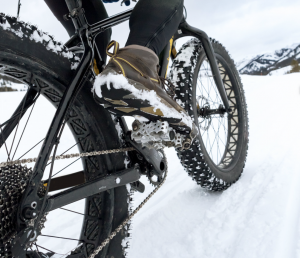With any type of hobby, trends come and go. For years and years, there was no such thing as a fat bike on the market. Then, fat bikes started to pop up in the 2000s and quickly shot up in popularity.
As great as fat bikes seem to be doing on paper, are fat bikes a fad? Are fat bikes actually dying slowly? While it might seem impossible to say for certain, taking a look at how fat bikes a fared over the years can give a stronger answer.
The Early Makings of Fat Bikes

Fat bikes came to be what they are today thanks to necessity. Not only were people looking for better options to ride in the snow in very extreme areas like Alaska, but desert riding the sand also required a big tire.
With no fat bike options out there just yet, people started by being creative and making their own bike that can hold up against harsh conditions.
What eventually happened was that manufacturers took notice. They realized that a tire that mimicked an all-terrain vehicle might be the solution on a bike. Thus, the oversized mountain bike, now known as a fat bike, was born.
Making Its Worldwide Debut
It’s crazy to believe that it was just 2005 when Surly made a mass-produced fat bike that was the first of its kind.
When their fat bikes started turning into mainstream options and sold well, other companies joined in. Now, some of the top companies in the world make fat bikes to appease the masses.
Those early days for fat bike users were a bit rough. Not only were companies experimenting to see what actually worked, but prices were very high.
It was a lot of money developing a brand new type of bike, and with a lack of competition, prices always seemed too high for some casuals.
Becoming Popular
Fat bikes had their peak popularity in the early 2010s. Riders became very intrigued by these rugged, yet comfortable bikes that could go anywhere.
Price points dropped to the point that it made financial sense for some to go with a fat bike over a traditional mountain bike.
These were the hot new bikes in town, and many top manufacturers were pushing their products hard.
They knew that not everyone would truly benefit from a fat bike, but it was a way to get some shoppers to invest in another bike to add to their collection.
Many found themselves trying brand new trails with their fat bikes, which is always a positive in the riding community. Any type of bike that gets someone out and enjoying themselves is viewed as a positive.
Have Fat Bikes Peaked?

As mentioned previously, it’s been about ten years since fat bikes reached their peak popularity. It seems like every year, a new well-known bike company was putting out their own fat bike to capitalize on sales during that time.
Very popular bike companies like Specialized and Trek embraced the fat bike movement, which only pushed it into the mainstream more and more.
Since that was still somewhat recent, one could see how things are going with sales and wonder if the fat bike riding has peaked. However, some people still have that first fat bike they purchased, and it still runs well since it’s not used all that often.
People really into the sport go through fat bikes pretty regularly, but others who are casual riders know that these are durable bikes.
There’s a good chance that many people are sitting on top of one that is over a decade old, and they don’t really see a reason to upgrade at this point.
Whether or not they were purchased in the first place because it was the trendy thing to do is debatable.
Why Do Some People Hate Fat Bikes?

Whenever a new type of bike becomes popular, plenty of people are ready to hate on them instead of embracing them.
That happened to fat bikes once they started to become mainstream, and riders still get some snide remarks and dirty looks here and there.
The main reason people seem to hate on fat bikes is that people use them for the wrong reasons. For example, riding a fat bike on the road in the middle of the summer seems completely out of place.
Here a person is riding with an extreme type of bike to handle the toughest terrains possible, and they are going on a smooth, paved road. It seems to the typical person as a giant waste of money.
Fat bikes also tend to be on the expensive side, so people don’t like the fact that those not in the know will end up spending a good amount of money on a bike that is way too much for them.
They don’t even know how to maximize the fat bike, but they just purchased it because it seemed like the right thing to do.
The truth is, there are high-end models for any type of bike out there. The same things that can be said about fat bikes can also be said about all-carbon road bikes, very expensive mountain bikes, and other options out there.
Ultimately, if a person wants to purchase a fat bike and feels like it is worth it, there’s no reason not to.
Do Fat Bikes Have a Strong Future?

Despite some people being down on fat bikes, they still have a strong future in their own part of the biking community. Riding on snow and sand is very difficult with any other type of bike, so a lot of people will stick with what they enjoy best.
Since fat bikes are still so new, many believe there is still a lot of innovation left within the industry. A lot of companies continue to pour money into research, testing setups to see what works best.
The fat bike industry isn’t going anywhere, but it just might not be growing as fast as some people originally thought.
Final Verdict: Are Fat Bikes a Fad?
As far as mainstream bike options are concerned, fat bikes are a bit on the extreme side. For that reason, at the height of their popularity, it did become somewhat of a fad in the eyes of some.
That’s not to say that they don’t serve their purpose, because riders in extreme conditions will gladly say otherwise, but it just doesn’t make sense for the average casual rider.
It is true that there is a way to enjoy different types of rides on a fat bike, but the same can be said for a mountain or gravel bike for a casual rider.
Most who are not experienced are not going to go into tough situations where they need tires that are fat bike size.
What ends up happening is people spend more money on a brand new bike than they need to, and the weight is hard to move around. They would be better served for something a bit more minimal.
Fat bikes don’t deserve the hate they have received from some in the bike community, as they are perfect solutions in the mountains and snowy conditions.
For example, fat bikes will continue to thrive in places like Alaska or certain parts of Canada, as it is the best option to get around on snow. Even without snow, fat bikes absorb so many bumps along the way that the ride is extremely smooth.
It is true that fat bikes are not going to ultimately replace some of the staples out there, but realistically, that never was supposed to happen in the first place.
They had their initial surge, but now they are settling in as a niche type of option that can be perfect for some, and a waste of money for others.
The good news is that many companies passionate about fat bikes are committed to being innovative with new releases.


One thought on “Are Fat Bikes a Fad / Are FatBikes Dead? ANSWERED!”